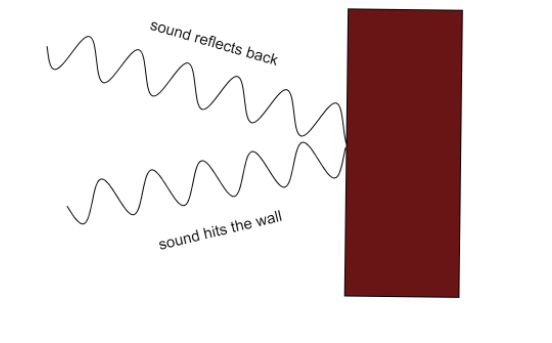
Echo is due to
(A) Reflection of sound
(B) Refraction of sound
(C) Both reflection and refraction of sound
(D) Diffraction of sound
Answer
217.8k+ views
Hint Just like light, the sound wave can reflect off surfaces too. Unlike light waves, sound waves have a very long wavelength. Thus, sound waves require a much bigger area to get reflected as compared to the light wave.
Complete step by step answer:

When a sound wave (longitudinal wave) occurs on a flat and hard surface, it reflects back. This phenomenon of reflection of sound is called echo. For this phenomenon, it is required that the reflecting surface should be much bigger as compared to the wavelength of the sound wave.
A reflected sound can be heard separately and distinctly from the source only if the source is very close to the listener and the reflecting surface is comparatively far from the listener.
Practically, this condition can be realized by the example that we often experience echoes near the mountain (where reflecting surface i.e. the mountains are very far) but if you stand in front of a wall and speak loudly, you don’t observe this phenomenon.
Additional Information
In the case of a numerical, you should keep in mind that the distance travelled by sound waves is double the distance between the source and reflecting surface. So, the velocity of sound can be given as
\[v = \dfrac{{2d}}{t}\]
Where, $d$ is the distance between the source and reflecting surface.
$t$ is the time taken to cover that distance.
Note
Keep in mind that any wave can undergo reflection, refraction, and diffraction. However, the conditions for these to happen depends on the wave. So if a light wave is diffracted by an object, it doesn’t necessarily mean that a sound wave will be diffracted too.
Complete step by step answer:

When a sound wave (longitudinal wave) occurs on a flat and hard surface, it reflects back. This phenomenon of reflection of sound is called echo. For this phenomenon, it is required that the reflecting surface should be much bigger as compared to the wavelength of the sound wave.
A reflected sound can be heard separately and distinctly from the source only if the source is very close to the listener and the reflecting surface is comparatively far from the listener.
Practically, this condition can be realized by the example that we often experience echoes near the mountain (where reflecting surface i.e. the mountains are very far) but if you stand in front of a wall and speak loudly, you don’t observe this phenomenon.
Additional Information
In the case of a numerical, you should keep in mind that the distance travelled by sound waves is double the distance between the source and reflecting surface. So, the velocity of sound can be given as
\[v = \dfrac{{2d}}{t}\]
Where, $d$ is the distance between the source and reflecting surface.
$t$ is the time taken to cover that distance.
Note
Keep in mind that any wave can undergo reflection, refraction, and diffraction. However, the conditions for these to happen depends on the wave. So if a light wave is diffracted by an object, it doesn’t necessarily mean that a sound wave will be diffracted too.
Recently Updated Pages
Elastic Collision in Two Dimensions Explained Simply

Elastic Collisions in One Dimension Explained

Electric Field Due to a Uniformly Charged Ring Explained

Electric Field of Infinite Line Charge and Cylinders Explained

Electric Flux and Area Vector Explained Simply

Electric Field of a Charged Spherical Shell Explained

Trending doubts
JEE Main 2026: Application Form Open, Exam Dates, Syllabus, Eligibility & Question Papers

Derivation of Equation of Trajectory Explained for Students

Hybridisation in Chemistry – Concept, Types & Applications

Understanding the Angle of Deviation in a Prism

Understanding Collisions: Types and Examples for Students

How to Convert a Galvanometer into an Ammeter or Voltmeter

Other Pages
JEE Advanced Marks vs Ranks 2025: Understanding Category-wise Qualifying Marks and Previous Year Cut-offs

Units And Measurements Class 11 Physics Chapter 1 CBSE Notes - 2025-26

NCERT Solutions For Class 11 Physics Chapter 8 Mechanical Properties Of Solids

Motion in a Straight Line Class 11 Physics Chapter 2 CBSE Notes - 2025-26

NCERT Solutions for Class 11 Physics Chapter 7 Gravitation 2025-26

Understanding Atomic Structure for Beginners




